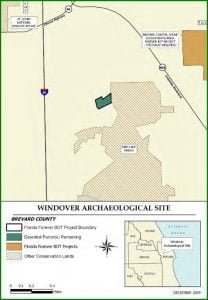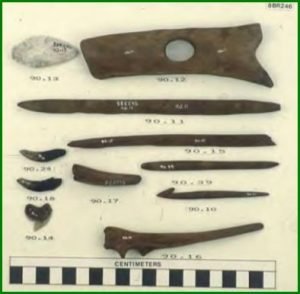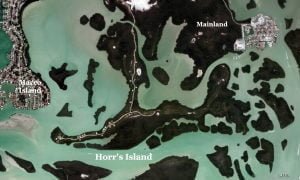Archaeologists define the Archaic Period in southern Florida as lasting from around 7500 BC to around 500 BC. 1 During the first half of this period, there were (in geological time) rapid environmental changes in the Florida Peninsula. In the latter half of this period, there were rapid cultural changes in Southeastern North America, but it is not known at the present time how completely those changes were manifested in southern Florida. A cultural connection between the Lake Okeechobee Basin and northeast Georgia remains little known, both inside and outside the archaeology profession.
The Younger Dryas Stadial was a (1,300 ± period of cold climatic conditions and drought which occurred between approximately 10,800 and 9,500 years BC. 2 Climatologists believe that the Gulf Stream shut down during this period. This could have potentially caused stark environmental changes in the Florida Peninsula, since heat energy would have not been transported across the Atlantic Ocean to Europe.
Between 11,000 and 7,000 BC there was widespread extinction of large mammals in North America. Notable extinctions in Florida during this period included the American Mastodon, Florida Speckled Bear and Giant Sloth. 3 No evidence has been found of mastodons living in South Florida. There were no natural barriers between southern and northern Florida, which would have blocked migration, but the southern part of the peninsula may have lacked suitable vegetation for the mastodon diet.
Early Archaic Period (8000 BC to 6000 BC)
During this period, ocean levels rose dramatically, due to the melting of the North American glacial sheet. 4 This resulted in both the land area declining rapidly and water tables rising in the remaining landscape. Areas that would have been inhospitable due to arid conditions became increasingly verdant.
Archaeologists believe that the inhabitants of Florida were culturally similar to those of the rest of the Southeast until the big game animals died off. 5 In order to survive, the region’s inhabitants would have be required to shift to a omnivore, hunting and gathering lifestyle that included the hunting and trapping of small game, fishing, nut harvesting, root digging and berry/fruit gathering.
There may have been few humans in southern Florida at this time, or that they were concentrated on the coast that is now underwater, where they lived of seafood. The fact that the only evidence of Early Archaic Period artifacts is coming from sink holes near the Gulf Coast support both speculations. Whatever the case, little evidence has been found for their existence. As a result, Florida archaeologists have viewed this period as a “cultural break.” However, it could be that they have just not looked in the right places for evidence of human habitation. The evidence may be under the sea floor or buried beneath deep peat deposits.
Middle Archaic Period (6000 BC to 3000 BC)
The climate and vegetation of southern Florida became increasingly like the present environment during this period. 6 Rising water tables created conditions in which the region’s current flora and fauna could thrive. Simultaneously, the land area shrank. What were South Florida’s ideal habitats for human hunters and gatherers in 6000 BC were under water by 3000 BC. This distorts South Florida’s archaeological record. The evidence of advanced cultural achievements may be under the ocean floor.
Evidence of mankind’s presence in southern Florida has definitely been identified at sites dating from 6,000 BC. 7 These artifacts have been found in sinkholes, springs and peat bogs. The peat preserves organic materials such as bone, wood and some woven fabrics, so they are particularly valuable locations for archaeological studies. Middle Archaic artifacts discovered include bone and stone hunting points, throwing sticks (atlatls,) digging sticks, wooden tools, carved wooden art, shell tools and skeletons. It should be noted that Florida archaeologists consider shell tools to be unique to South Florida, but actually they were quite common on the coast of South Carolina and Georgia – even in the Georgia Piedmont.
Formal mortuary patterns appeared. Bodies were buried on the edges or within shallow ponds. This practice marks a change from a long period where few skeletons have been found.
Windover Bog Archaeological Site

Few examples of this mortuary practice have been found in South Florida, but a spectacular example was excavated at the Windover Site in Brevard County, FL (east central, Atlantic Coast.) 8The section of the bog excavated contained 169 male and female skeletons, ranging in age from infants to about 60 years. The average height of males was 5’-9” (168 cm.) The average height of adult males was 5 feet 9 inches (175 cm).
Forensic studies of the skeletons identified evidence of disease and healed wounds. Many children’s bones showed interrupted growth, interpreted as being caused by severe diseases or malnutrition. Osteoporosis was visible in older females, caused by chronic calcium deficiencies. 9 Adults of both sexes exhibited a high incidence of osteoarthritis. Some skeletons showed wounds that were the probable the cause of death. The pelvis of one male had a bone spear point embedded in it. This is proof that warfare existed in that era. Others skeletons had severe skull fractures, which most likely occurred during warfare or hunting.
Organic samples from Windover Pond were dated to between 5,210 BC and 5,320 BC. 10 Skeletal remains excavated at Windover were so well preserved by the anaerobic peat, that brain material still survived within the skulls. Many artifacts that were deposited with the bodies were preserved.

Many references state that American Indians in eastern North America did not weave cloth until taught to do so my European colonists. Archaeologists, working at Windover, excavated 86 pieces of fabric from 37 graves. 11 These fabrics included seven distingué textile weaves. They were used for clothing, bags, matting, and possibly blankets and ponchos. Atlatls and projectile points were also found at Windover. The occupants of Windover hunted animals, fished, and gathered plants. They used bottle gourds for storage, which comprise the earliest evidence for vegetable container storage discovered in North America. Animal bones and shells unearthed in the bog, indicated that the people ate white-tailed deer, raccoon, opossum, birds, fish and shellfish.
Several publications on South Florida Native American cultures state that the bodies were buried beneath the surface of the water. 12 This may or may not be accurate. The archaeologists, who worked at Windover, have determined that the water table was much lower around 5,200 BC. The original pond was above the water table and only temporarily filled with rainwater. The bodies were held to the ground with fabric and wooden stakes, but this technique could have at least three interpretations. The location may have been subject to temporary flooding from rainstorms. It is now. The staking tradition may have been necessary to keep out scavengers or carrion eaters. Finally, the stakes and fabric may have been composed tent-like enclosures over the graves that where then covered with dirt or brush.
Horr’s Island

Around 6000 BC, a site on Horr’s Island, near Fort Myers, FL was first occupied. 13 The oldest known mound, which is really a refuse midden, began to build up around 4700 BC. Human beings lived here much of the time until around 1000 BC. Various samples from Mound A have been dated to 1620-2760 BC. Mound D, the other purpose-built mound, has been dated to 2450 BC. Mound C has been dated to 2870-2860 BC. Samples from Mound B yielded dates between 4730 and 2030 BC. Two burials within a completed Mound A were dated to about 1400 BC. Some articles claim that it is the oldest known burial mound in North America. However, there are older mounds in Louisiana.
Evidence of domestic architecture has been found at Horr’s Island. Over 600 small post holes in circular patterns were identified by archaeologists. These were apparently the footprints left by small houses that were created by inserting saplings in the soil and tying them together.
Because there was no source of stone in the region that could be sharpened to a point or blade, most of the cutting tools at Horr’s Island were fabricated from shells. There were some stone hammers and slabs found that were worked from a type of sandy limestone found locally.
Elsewhere in the Southeastern United States
Although fascinating, the burials in such locations as Windover Bog and Warm Mineral Springs (Part One) are not complete “snapshots” of cultures. The presence of seven types of woven fabrics suggests that the Windover People were much more that simple hunters and gatherers. Perhaps the bounty of the sea made a richer culture possible.
Around 3500 BC, the earliest large scale public works were being constructed at Watson Brake, Louisiana. 14 The ceremonial site consists of an earthen ring with at least 11 mounds built upon it. Did the inhabitants of South Florida also build earthworks that early? The answer is that no example has been found at the present time, but it is possible that such structures are now covered with ocean water or were leveled by hurricanes through the eons.
What is probably the oldest pottery in the Americas has been found in the Lower Amazon Basin and dated to about 7000 years ago. 15 Pottery making spread outward slowly from that location then skipped to the Savannah River Basin of Georgia and South Carolina about 5,000 years ago.
Late Archaic Period (3000 BC – 700 BC)
The climate and ecology of South Florida around 3000 BC was similar to that of today, although the water table was somewhat lower. 16 Permanent swamps, ponds and bogs today were primarily seasonal rain-fed ponds at that time.
In southern Florida, the Late Archaic Period appears to be a time when mankind gradually honed its skills at adapting to the local environment. Generation after generation, innovations and observations would be made that added to the body of knowledge. Humans learned how to maximize their natural food supply.
Archeologists have not been able to identify as many Late Archaic archaeological sites in South Florida as there are Middle Archaic sites. 17 This is opposite to the situation elsewhere in the Southeast. The cause of this scarcity is that the archaeologists may be looking in the wrong places or for the wrong evidence. For example, the majority of these peoples may have lived in timber platform villages. The evidence would be found under the peat of ponds and lakes.
Pottery appeared in southern Florida around 4000 to 4800 years ago. 18 It is not clear if the technology was passed southward to the region or northward from South America. South Florida pottery was fiber tempered, most likely with Spanish moss. The ceramics in Georgia was also fiber tempered.
Florida archaeologists label the initial time interval of fiber tempered ceramics as “the Orange Period.” 19 Pottery in southern Florida is subdivided into periods that are marked by shifts in the Orange ceramics styles. The last interval of the Orange Period is termed the Transitional Period (950-450 B.C.) because fiber tempering was replaced by limestone tempering.
Around 2500 BC, shell ring construction began on the coast of Georgia and southern South Carolina, centered at the mouth of the Altamaha River. 20 As Georgia’s Shell Ring Culture peaked, it began moving down the coast of Florida. Shell rings were still being occupied and expanded on Southern Florida’s coast after around 1200 BC, when they had been abandoned in Georgia.
In 1658, French ethnologist and naturalist, Charles de Rochefort wrote a book about the natural history of the Caribbean Basin, that included a chapter on the indigenous peoples of what is now Georgia. It was entitled, l’Histoire naturelle et morale des îles Antilles de l’Amérique. 21 Although completely ignored by American historians and anthropologists, it is held in high esteem by European scholars. 22 To De Rochefort’s credit, his detailed description of the Apalache Kingdom in northern Georgia has turned out to be very accurate, while this culture was completely missed by contemporary archaeologists.
De Rochefort stated that the Caribs originated on the Georgia and South Carolina coasts. At the time of their origin, they were the most advanced people in Southeastern North America. In other words, they built the shell rings. He said that they gradually migrated southward across the Florida Peninsula and western Antilles until the lead elements reached the northern coast of South America then began to spread outward into the Caribbean Basin.
In fact, the construction of shell rings did spread in that same manner. De Rochefort’s theory may also explain the identity of the Tequesta People of southeastern Florida. Although labeled “Arawaks” by some, anthropologists have never been comfortable with that label, since culturally the Tequesta seemed different than the Taino Arawaks in the Antilles. They also shared ferocious military traits with the Caribs.
At the present time, South Florida appears to have lagged culturally behind the indigenous peoples living farther north and west in the Southeast. Native peoples in these other regions were growing food in gardens and trading over long distances. It was not necessary for these more northerly peoples to travel the full length of the Florida Peninsula to obtain items desired from the coast.
On the other hand, the semi-tropical environment of southern Florida supplied a year round bounty of natural foods. There was no need to develop means of producing and storing non-perishable food for the winter. As a general rule, humans do not rapidly advance technologically and culturally, when they are not challenged by their environment. However, South Florida was soon to become a very precocious locale in North America.
Citations:
- Florida Division of Historical Resources. 10000-3000 BC.[
]
- Berger, W. H. (1990). “The Younger Dryas cold spell – a quest for causes“. Global and Planetary Change: 219–237.[
]
- Florida Division of Historical Resources. 10000-3000 BC.[
]
- Florida Division of Historical Resources. 10000-3000 BC.[
]
- Florida Division of Historical Resources. 10000-3000 BC.[
]
- Florida Division of Historical Resources. 10000-3000 BC.[
]
- Florida Division of Historical Resources. 10000-3000 BC.[
]
- “Windover Archeological Site“. National Historic Landmark summary listing. National Park Service.[
]
- Brown, Robin C. (1994). Florida’s First People: 12,000 Years of Human History. Sarasota, Florida: Pineapple Press; pp. 21-24.[
]
- Brown, Robin C. (1994). Florida’s First People: 12,000 Years of Human History. Sarasota, Florida: Pineapple Press; pp. 21-24.[
]
- Brown, Robin C. (1994). Florida’s First People: 12,000 Years of Human History. Sarasota, Florida: Pineapple Press; pp. 21-24.[
]
- Brown, Robin C. (1994). Florida’s First People: 12,000 Years of Human History. Sarasota, Florida: Pineapple Press; pp. 21-24.[
]
- Brown, Robin C. (1994). Florida’s First People: 12,000 Years of Human History. Sarasota, Florida: Pineapple Press; pp. 31-36.[
]
- “A Mound Complex in Louisiana at 5400-5000 Years Before the Present“, Science, 19 Sept. 1997.[
]
- Wilford, John Noble, “Oldest Pottery in Americas Is Found in Amazon Basin.” New York Times: December 13, 1991.[
]
- Florida Division of Historical Resources. 10000-3000 BC.[
]
- Florida Division of Historical Resources. 10000-3000 BC.[
]
- Florida Division of Historical Resources. 10000-3000 BC.[
]
- Florida Division of Historical Resources. 10000-3000 BC.[
]
- Thompson, Victor. “Coastal Shell Rings.” New Georgia Encyclopedia. 05 June 2014. Web. 30 September 2014.[
]
- De Rochefort, Charles. , l’Histoire naturelle et morale des îles Antilles de l’Amérique. Rotterdam: Chez Arnout Leers, Marchant Libraire, 1658.[
]
- Searching on Google, the name of Charles de Rochefort or the name of his book in French produces numerous books, dissertations and academic papers from France, Belgium, the Netherlands and Germany.[
]
